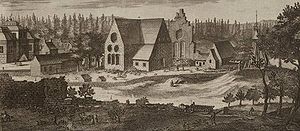
Nydala Abbey
Encyclopedia

Småland
' is a historical province in southern Sweden.Småland borders Blekinge, Scania or Skåne, Halland, Västergötland, Östergötland and the island Öland in the Baltic Sea. The name Småland literally means Small Lands. . The latinized form Smolandia has been used in other languages...
, Sweden
Sweden
Sweden , officially the Kingdom of Sweden , is a Nordic country on the Scandinavian Peninsula in Northern Europe. Sweden borders with Norway and Finland and is connected to Denmark by a bridge-tunnel across the Öresund....
, near the lake of Rusken.
Nydala (from Swedish ny, meaning new, and dal, meaning valley) was called Sancta Maria de Nova Valle or just Nova Vallis in Latin
Latin
Latin is an Italic language originally spoken in Latium and Ancient Rome. It, along with most European languages, is a descendant of the ancient Proto-Indo-European language. Although it is considered a dead language, a number of scholars and members of the Christian clergy speak it fluently, and...
. It was founded together with Alvastra Abbey
Alvastra Abbey
Alvastra Abbey was a Cistercian monastery located at Alvastra in Östergötland, Sweden. It was founded in the first half of the 12th century by a donation of land from King Sverker I of Sweden to the Cistercian Order. It was dissolved and appropriated by the Crown at the time of the Protestant...
in 1147 as the first cistercian monasteries in Sweden. King Gustavus Vasa
Gustav I of Sweden
Gustav I of Sweden, born Gustav Eriksson of the Vasa noble family and later known simply as Gustav Vasa , was King of Sweden from 1523 until his death....
appropriated the abbey in the 1520s, and the Danes sacked it in 1568. Part of the abbey church was rebuilt in the following years, and is still used as parish church. Some other ruins also remain visible at the site.

